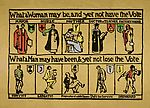 Suffragette propaganda poster
Suffragette propaganda poster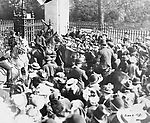 Suffragette riot at Buckingham Palace 1914
Suffragette riot at Buckingham Palace 1914 Suffragette being arrested 19th Nov. 1914
Suffragette being arrested 19th Nov. 1914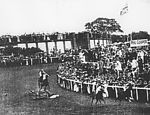 Emily Davison throwing herself in front of the King's horse at the 1913 Derby
Emily Davison throwing herself in front of the King's horse at the 1913 Derby Cat and Mouse Act poster
Cat and Mouse Act poster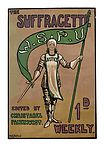 Poster advertising the 'Suffragette' newspaper
Poster advertising the 'Suffragette' newspaper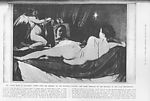 Velasquez slashed by suffrage protesters
Velasquez slashed by suffrage protesters Lloyd George's house bombed
Lloyd George's house bombed

SUFFRAGISTS - people who support suffrage, the right or privilege of voting.
The only members of society who could vote during the mid 19th century were male, aged 21 years and over, owning or renting property of £10 per year.
In 1865 a group of women petitioned parliament to grant women the right to vote. They were defeated, and so they formed The London Society for Women’s Suffrage. Societies formed around the country, and in 1887 many joined together to form the National Union of Women’s Suffrage Societies.
The N.U.W.S.S., led by Millicent Fawcett, campaigned for many causes in many ways. They organised meetings and petitions, published literature, wrote to politicians and supported other women campaigners. They believed in the power to change through persuasion.
In 1903 a breakaway group formed the Women’s Social and Political Union, led by Emmeline Pankhurst. This group was frustrated by the peaceful campaigning methods of the N.U.W.S.S. The W.S.P.U. believed that if men would not listen to peaceful campaigning, then women must use force to win the right to vote. The methods used by the women became more extreme with time, including damage to public buildings, attacks on politicians, disrupting Parliament, and when arrested, going on hunger strike. They were given the name "suffragettes" by the Daily Mail in 1906.
Some members of the W.S.P.U. felt the leadership was making too many decisions without asking the members. In 1909 a break away group formed the Women’s Freedom League. They were a non-violent group, critical of the W.S.P.U.’s extreme actions, although its members were arrested for demonstrating.
Concern grew that the extreme actions of the W.S.P.U. was harming the cause of the more peaceful suffragists. Though the courage shown by the suffragettes was admired, the anti-suffrage movement used the actions of the suffragettes to undermine the suffragist movement, and show why women should not be allowed to vote. As the extreme actions started to scare people away from supporting suffrage, some publicity was produced to define the difference between the two styles of campaigning.
The outbreak of World War One in 1914 led many groups to stop their campaigns, and support the war effort. The W.S.P.U. leaders offered total support to the war effort. The W.F.L. did not agree with the suspending of action, and supported the Women’s Peace Council throughout the war in campaigning for a negotiated peace.
Women over the age of 30 gained the right to vote and to stand for Parliament as MPs at the end of the war, in 1918. This angered many women as the right to vote was seen as thanks for their work during the war, but much of this work was done by the younger unmarried women; who were not the ones given the vote. It took another 10 years of campaigning before, in 1928, all women were finally given the vote.
It is important that we recognise that there are still women throughout the world, who have few rights, and the penalty they suffer for speaking out and campaigning for a fair society can be torture and death.
Rollover the captions in the box to see the available images in thumbnail format, click the caption to see the full-size image
| Reference: | 721 |
| Keywords: | |
| Archive Ref: | |
| Updated: | Wed 12 Mar 2008 - 1 |
| Interpretation written by | Jenny Ermoyenous |
| Author's organisation | Curatorial |
| Organisation's website |